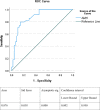Categorization of differences of sex development among Egyptian children and the role of antimullerian hormone and inhibin B
- PMID: 36686446
- PMCID: PMC9858568
- DOI: 10.3389/fendo.2022.1072399
Categorization of differences of sex development among Egyptian children and the role of antimullerian hormone and inhibin B
Abstract
Background: Differences of sex development (DSD) are congenital conditions linked to atypical development of chromosomal, gonadal, or anatomical sex.
Objective: The aim of this study was to demonstrate our experiences at the Diabetes Endocrine and Metabolism Pediatric Unit (DEMPU), Faculty of Medicine, Cairo University in the field of DSD by focusing on the clinical presentation, laboratory profile, classification, and etiological diagnosis of these conditions. In addition, the present study intended to delineate the importance of serum anti-Müllerian hormone (AMH) and inhibin B in detecting the presence of functioning testicular tissue.
Methods: This cohort study included 451 infants and children with various clinical presentations of DSD. The study performed a retrospective analysis on medical records of established DSD cases to evaluate the clinical importance of AMH and inhibin B. In addition, newly diagnosed patients were prospectively analyzed.
Results: Three hundred thirty-six (74.5%) patients were 46,XY DSD, 98 (21.7%) were 46,XX DSD, 14 patients had other karyotypes and 3 had missing karyotypes. Among the 46XY DSD patients, the most common cause was partial androgen insensitivity. In contrast, congenital adrenal hyperplasia constituted the most common diagnosis in 46,XX DSD cases. The cut off value of serum AMH was 14.5 ng/ml with 100% sensitivity and 55.1% specificity.
Conclusion: Partial androgen insensitivity was the most important cause of 46,XY DSD in Egyptian children, and congenital adrenal hyperplasia was the most common cause of 46,XX DSD. AMH was valuable in detecting functioning testicular tissue.
Keywords: androgen insensitivity syndromes; anti-mullerian hormone; atypical genitalia; congenital adrenal hyperplasia; differences of sex development; inhibin B.
Copyright © 2023 Abdelghaffar, AbdelMoneam, Hassanein, Radwan and Mira.
Conflict of interest statement
The authors declare that the research was conducted in the absence of any commercial or financial relationships that could be construed as a potential conflict of interest.
Figures



Similar articles
-
Etiological classification and clinical spectrum of Egyptian pediatric patients with disorder of sex development, single center experience.Endokrynol Pol. 2021;72(5):558-565. doi: 10.5603/EP.a2021.0045. Epub 2021 May 19. Endokrynol Pol. 2021. PMID: 34010442
-
Etiological classification and clinical assessment of children and adolescents with disorders of sex development.J Clin Res Pediatr Endocrinol. 2011;3(2):77-83. doi: 10.4274/jcrpe.v3i2.16. Epub 2011 Aug 6. J Clin Res Pediatr Endocrinol. 2011. PMID: 21750636 Free PMC article.
-
Risk association of congenital anomalies in patients with ambiguous genitalia: A 22-year single-center experience.J Pediatr Urol. 2018 Apr;14(2):153.e1-153.e7. doi: 10.1016/j.jpurol.2017.09.027. Epub 2017 Nov 20. J Pediatr Urol. 2018. PMID: 29157626
-
Molecular diagnostics of disorders of sexual development: an Indian survey and systems biology perspective.Syst Biol Reprod Med. 2019 Apr;65(2):105-120. doi: 10.1080/19396368.2018.1549619. Epub 2018 Dec 14. Syst Biol Reprod Med. 2019. PMID: 30550360 Review.
-
What Does AMH Tell Us in Pediatric Disorders of Sex Development?Front Endocrinol (Lausanne). 2020 Sep 8;11:619. doi: 10.3389/fendo.2020.00619. eCollection 2020. Front Endocrinol (Lausanne). 2020. PMID: 33013698 Free PMC article. Review.
Cited by
-
Anti-Müllerian hormone, testicular descent and cryptorchidism.Front Endocrinol (Lausanne). 2024 Mar 4;15:1361032. doi: 10.3389/fendo.2024.1361032. eCollection 2024. Front Endocrinol (Lausanne). 2024. PMID: 38501100 Free PMC article. Review.
References
-
- Mehmood KT, Rentea RM. Ambiguous genitalia and disorders of sexual differentiation. In: StatPearls. Treasure Island (FL: StatPearls Publishing; (2021). - PubMed
MeSH terms
Substances
LinkOut - more resources
Full Text Sources

